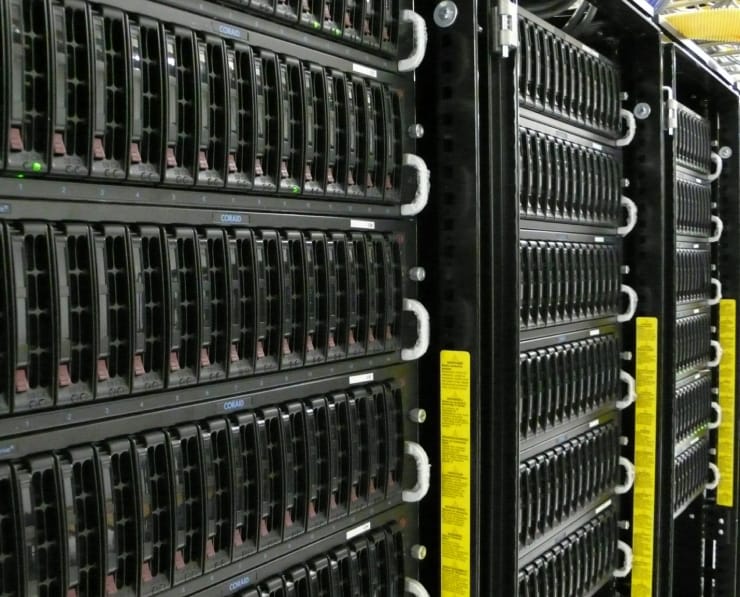Student Feedback
350-401: Implementing Cisco Enterprise Network Core Technologies (ENCOR) Certification Video Training Course Outline
Architecture
Virtualization
Infrastructure
Network Assurance
Security
6.0 Automation
Architecture
350-401: Implementing Cisco Enterprise Network Core Technologies (ENCOR) Certification Video Training Course Info
CCNP & CCIE Enterprise ENCOR 350-401 v1.1 Complete Certification Training
CCNP & CCIE Enterprise ENCOR v1.1 Training with Structured Notes for Easy Learning
What You Will Learn From This Course
• Gain the skills and knowledge to pass the Cisco ENCOR 350-401 v1.1 exam successfully
• Build hands-on experience with practical labs covering enterprise network configurations
• Develop advanced routing and switching expertise for professional network environments
• Understand the implementation of network security within enterprise networks
• Learn SD-Access and SD-WAN deployment and management
• Acquire troubleshooting skills for complex wired and wireless enterprise networks
• Master network automation techniques and configuration using modern tools
• Understand VLANs, STP, EtherChannel, and inter-VLAN routing
• Gain knowledge of dynamic routing protocols including OSPF and EIGRP
• Learn high availability solutions such as HSRP, VRRP, and FHRP concepts
• Understand ACLs, NAT, and PAT implementation for enterprise environments
• Gain practical knowledge of VPN technologies, GRE tunnels, and IPsec deployment
• Learn enterprise network monitoring using SNMP, NetFlow, Syslog, and AAA
• Understand QoS implementation for optimizing network performance
• Gain insight into network virtualization, VRF, and cloud-based enterprise networking
• Understand wireless networking concepts, AP states, client density, and security features
• Learn automation using REST APIs, NETCONF, and RESTCONF
• Understand multicast protocols and monitoring tools for large-scale networks
Learning Objectives
The primary objective of this course is to provide students with comprehensive knowledge and practical experience needed to operate, configure, and troubleshoot enterprise networks. Students will learn how to deploy secure and optimized routing and switching solutions, implement high availability features, and integrate modern technologies such as SD-Access and SD-WAN. By the end of the course, students will be capable of managing enterprise wired and wireless networks, understanding complex protocols, and applying automation for network efficiency. Students will also be able to design and maintain enterprise network infrastructure following industry best practices and Cisco recommendations.
Target Audience
This course is ideal for professionals who are seeking to enhance their networking knowledge and prepare for advanced certifications. Targeted learners include network administrators, network support technicians, enterprise network engineers, help desk technicians, and system administrators. It is also suitable for IT professionals who want to gain hands-on experience in routing, switching, security, and automation within large-scale enterprise networks. Students planning to pursue CCNP Enterprise or CCIE Enterprise certification will benefit greatly from the structured content and practical lab exercises provided in this course.
Requirements
To make the most out of this course, learners should have some foundational knowledge and skills. Familiarity with networking concepts, basic LAN configuration, and IP addressing is recommended. Students should be comfortable working with network devices and have an understanding of core networking protocols and terminology. Basic experience with configuring routers and switches, and familiarity with Cisco IOS commands, will help in following the labs effectively.
Prerequisites
Before starting this course, students should have a foundational understanding of networking principles covered in CCNA Routing and Switching 200-125 or CCNA 200-301. This includes knowledge of basic network design, IP addressing, subnetting, routing, switching, and introductory network security. A general understanding of how to manage network devices and implement LAN technologies is required. Basic exposure to network automation concepts is advantageous but not mandatory. The course is designed to build on these prerequisites, moving learners from foundational knowledge to advanced enterprise network management and troubleshooting.
CCNP-01 Introduction
The course begins with an introduction to Cisco enterprise network concepts, certification objectives, and the exam structure for ENCOR 350-401 v1.1. Students will understand the scope of the exam, the types of technologies included, and the skills that will be developed throughout the course. The introduction also highlights the importance of practical lab exercises and how they reinforce theoretical concepts. Students are guided through the tools and software platforms required for the course, including GNS3 and EVE-NG, which are used for hands-on simulation of enterprise network environments.
Installing GNS3 for CCNP Labs
This module covers the installation and configuration of GNS3, a network simulator widely used for Cisco certification preparation. Students learn how to download, install, and set up GNS3 on their local systems. The module also includes the configuration of virtual network devices, connecting routers, switches, and PCs within the GNS3 environment. Emphasis is placed on creating realistic network topologies to simulate enterprise scenarios for hands-on practice. Troubleshooting common installation and configuration issues is also covered to ensure students can operate the simulator effectively.
EVE-NG Installation and Configuration
EVE-NG is another critical tool for simulating enterprise network labs. This module guides students through downloading, installing, and configuring EVE-NG. It includes creating virtual labs, importing Cisco images, and establishing network connectivity between virtual devices. Students learn how to replicate complex network topologies in EVE-NG, which allows them to practice advanced routing, switching, and security configurations. This module ensures learners are comfortable with both GNS3 and EVE-NG, giving them flexible options for hands-on lab practice.
ARP Concepts with Lab
Address Resolution Protocol (ARP) is a fundamental networking concept covered in this course. Students learn how ARP functions to map IP addresses to MAC addresses within a network. The lab provides practical exercises to configure ARP entries manually, observe ARP tables, and troubleshoot ARP-related issues in a simulated network environment. Understanding ARP is essential for implementing VLANs, inter-VLAN routing, and troubleshooting connectivity issues in enterprise networks.
ARP Implementation on Switch
Building on ARP theory, this module demonstrates ARP behavior specifically on network switches. Students will configure ARP on Layer 2 and Layer 3 switches, analyze MAC address tables, and understand the relationship between ARP and switch forwarding decisions. Lab exercises reinforce the practical implementation of ARP entries and help learners identify potential ARP-related problems that can affect network performance and connectivity.
MAC Address Table Labs
Students will explore how switches maintain MAC address tables to forward frames within a LAN. The module covers dynamic and static MAC entries, aging timers, and the effect of MAC table overflow. Lab exercises provide hands-on experience configuring MAC addresses, verifying table entries, and troubleshooting issues with frame delivery across switches. Understanding MAC address tables is critical for VLAN segmentation, spanning tree protocol operations, and EtherChannel configuration.
VLAN Configuration and Labs
VLANs are fundamental for segmenting enterprise networks into logical broadcast domains. This module covers VLAN creation, assignment of switch ports to VLANs, trunking protocols, and VLAN management commands. Students will perform lab exercises configuring VLANs, verifying connectivity, and troubleshooting VLAN-related issues. The module emphasizes the role of VLANs in improving network performance, security, and organization.
Cisco Express Forwarding (CEF)
CEF is a high-performance packet forwarding technology in Cisco devices. This module explains how CEF optimizes routing performance, reduces CPU load, and enhances network stability. Lab exercises allow students to verify CEF operation, observe forwarding tables, and understand its impact on routing efficiency. CEF knowledge is essential for preparing for enterprise-level routing challenges and troubleshooting scenarios.
Basic Trunking Protocol Lab
This module introduces trunking between switches to allow multiple VLANs to communicate across a network. Students learn the differences between access and trunk ports, configure trunk links, and verify VLAN propagation across trunks. Lab exercises provide hands-on experience with trunking, including troubleshooting common issues such as VLAN mismatches or trunk negotiation failures.
Dynamic Trunking Protocol (DTP) Theory
DTP allows switches to negotiate trunking automatically. This module covers DTP modes, negotiation processes, and security considerations. Students learn how to control trunk formation, prevent unwanted VLAN propagation, and understand DTP behavior in multi-switch environments. Practical labs reinforce theoretical concepts and prepare learners for configuring secure trunk links in enterprise networks.
DTP Lab in GNS3
Students will perform hands-on exercises implementing DTP in a simulated GNS3 environment. The lab demonstrates trunk formation, verification of trunk status, and troubleshooting DTP-related issues. By the end of this module, students will have gained confidence in configuring dynamic trunks, understanding negotiation states, and applying DTP best practices to enterprise networks.
Course Modules / Sections
The course continues with advanced modules designed to enhance the learner's skills in routing, switching, network security, and enterprise network management. The modules build on foundational concepts introduced in Part 1 and provide in-depth theoretical knowledge coupled with extensive hands-on labs. These sections focus on spanning tree protocols, EtherChannel configurations, advanced routing protocols, high availability solutions, inter-VLAN routing, access control lists, NAT/PAT configurations, and enterprise network troubleshooting techniques. Each module is carefully structured to ensure a logical progression from basic concepts to complex enterprise network scenarios. The modules are designed for CCNP Enterprise and CCIE Enterprise candidates, but also cater to network engineers seeking to advance their practical knowledge and skills in enterprise networking.
The first set of modules in this part focuses on the Spanning Tree Protocol (STP). STP is critical for preventing loops in Layer 2 networks and maintaining network stability. Learners explore the principles of STP, including root bridge selection, port roles, and the effects of bridge priority and path cost on spanning tree topology. Practical lab exercises allow students to configure STP, verify its operation, and troubleshoot issues in a multi-switch environment. Advanced topics such as Multiple Spanning Tree (MST) are also covered, providing learners with the knowledge to design scalable and loop-free enterprise networks.
Following STP, the course covers EtherChannel technology, which allows multiple physical links to be combined into a single logical link for increased bandwidth and redundancy. Learners study the differences between PAgP, LACP, and static EtherChannel configurations. Hands-on labs demonstrate the creation of Layer 2 and Layer 3 EtherChannels, verification of load balancing across links, and troubleshooting of misconfigurations or failures. Understanding EtherChannel is essential for enterprise networks requiring high availability and efficient utilization of physical links.
Advanced routing protocol modules form a significant portion of this section. The course covers OSPF in depth, including single-area and multi-area configurations, router IDs, DR/BDR election, route summarization, load balancing, passive interfaces, filtering, and path selection. Learners perform labs using GNS3 and EVE-NG to configure OSPF in various topologies, verify routing tables, and troubleshoot neighbor relationships. EIGRP is also covered in detail, including metric calculation, route summarization, unequal cost load balancing, and advanced troubleshooting techniques. The course emphasizes the practical implementation of these protocols in enterprise networks to ensure reliability and efficiency.
High availability solutions are introduced through modules covering HSRP, VRRP, and FHRP concepts. Students learn how to configure and verify redundancy for critical gateway devices, ensuring uninterrupted network connectivity. Labs include simulations of failover scenarios, verifying priority settings, preemption, and state changes. This knowledge is crucial for enterprise networks where downtime can result in significant operational disruption.
Inter-VLAN routing is another key module. Learners explore multiple methods for routing between VLANs, including router-on-a-stick and Switched Virtual Interfaces (SVIs). Practical labs guide students through configuring and verifying inter-VLAN connectivity, troubleshooting common issues such as misconfigured trunk ports, and ensuring proper VLAN segmentation and isolation. Understanding inter-VLAN routing is essential for designing scalable and secure enterprise networks.
Access control lists (ACLs) and NAT/PAT configurations form an essential component of network security modules. Students learn how to implement standard, extended, and named ACLs to filter traffic based on source and destination IP addresses, ports, and protocols. NAT and PAT modules cover static, dynamic, and overload configurations, including lab exercises to simulate real-world enterprise scenarios. These modules emphasize the importance of traffic control, security, and address conservation in enterprise networks.
Automation and monitoring modules are introduced to provide learners with modern network management skills. Topics include REST API integration, NETCONF, RESTCONF, AAA, SNMP, NetFlow, Syslog, and debugging tools. Hands-on labs allow students to implement automation scripts, monitor network traffic, and ensure compliance with enterprise security policies. These modules prepare learners for managing large-scale networks efficiently and using automation to reduce manual configuration errors.
Wireless networking modules are included to provide a comprehensive understanding of enterprise WLAN design, AP states, client density, wireless segmentation, and security features. Labs simulate troubleshooting wireless issues, implementing EAPOL authentication, and configuring secure wireless access. Multicast protocols, VPN technologies, GRE tunnels, and IPSec are also covered, giving learners the ability to design and secure modern enterprise networks.
The course concludes this section with enterprise network design principles, cloud integration, virtualization concepts, VRF configurations, NTP, PTP, and advanced monitoring techniques. Students learn to plan, implement, and maintain scalable and secure networks, ensuring they are prepared for both CCNP Enterprise exams and real-world enterprise deployments.
Key Topics Covered
This section emphasizes core topics required for advanced enterprise networking:
Spanning Tree Protocol: STP, RSTP, MST, root bridge selection, port roles, path cost
EtherChannel: PAgP, LACP, static channel configuration, load balancing, redundancy
Advanced Routing Protocols: OSPF, EIGRP, route summarization, multi-area OSPF, DR/BDR election, path selection
High Availability Solutions: HSRP, VRRP, FHRP configuration and verification, failover simulation
Inter-VLAN Routing: Router-on-a-stick, SVI, trunking, VLAN segmentation, troubleshooting
Access Control Lists: Standard, extended, and named ACLs, traffic filtering, and security policies
NAT and PAT: Static NAT, dynamic NAT, port address translation, configuration, and verification
Automation and Network Monitoring: REST APIs, NETCONF, RESTCONF, AAA, SNMP, NetFlow, Syslog
Wireless Networking: AP states, client density, wireless segmentation, troubleshooting, security features
VPN and Tunneling: GRE tunnels, IPSec, site-to-site VPN configuration, verification
Enterprise Network Design: Cloud integration, virtualization, VRF, NTP, PTP, advanced monitoring
Troubleshooting: Layer 2 and Layer 3 issues, routing protocol failures, VLAN and trunk problems, EtherChannel verification, ACL and NAT/PAT troubleshooting
Teaching Methodology
The course adopts a structured, hands-on teaching methodology to ensure learners gain both theoretical knowledge and practical skills. Instruction begins with clear explanations of networking concepts, followed by detailed demonstrations and lab exercises. Learners are encouraged to replicate lab configurations using GNS3, EVE-NG, and real Cisco devices where available. Each module includes step-by-step instructions, configuration examples, and verification commands to reinforce learning.
Labs are designed to simulate real-world enterprise scenarios, enabling students to troubleshoot issues, optimize configurations, and apply best practices. Teaching methodology emphasizes a progressive learning approach, starting with foundational concepts and moving toward advanced topics. Regular assessments, practical exercises, and review sessions are incorporated to ensure learners retain knowledge and gain confidence in applying skills in enterprise environments.
In addition to labs, the methodology includes visual aids, diagrams, and topology illustrations to enhance conceptual understanding. The course also encourages learners to document their configurations and develop problem-solving strategies that are essential for network administration and certification exams. Active learning and continuous practice are key components, ensuring students can manage complex enterprise networks efficiently.
Assessment & Evaluation
Assessment in this course is designed to evaluate both theoretical understanding and practical skills. Learners complete lab exercises that simulate enterprise network configurations, requiring accurate implementation, verification, and troubleshooting. Lab exercises are followed by practical assessments, where learners configure network devices according to specific requirements and validate network performance.
Written assessments and quizzes are incorporated to test knowledge of routing protocols, STP, EtherChannel, inter-VLAN routing, ACLs, NAT/PAT, high availability, automation, and network security principles. These evaluations ensure that learners not only understand theoretical concepts but can also apply them in practical environments.
Performance in lab exercises is measured based on accuracy, adherence to best practices, and the ability to troubleshoot issues effectively. Learners are provided with feedback to improve skills and address gaps in knowledge. The combination of theoretical assessment and hands-on evaluation prepares students for Cisco ENCOR 350-401 certification exams and real-world enterprise networking challenges.
Learners are also encouraged to maintain a lab journal documenting configurations, troubleshooting steps, and solutions to common network problems. This journal serves as a valuable reference for exam preparation and career development. Continuous evaluation ensures that learners achieve mastery of enterprise networking topics, gain confidence in their skills, and are well-prepared for professional roles in network administration, enterprise network engineering, and system administration.
This section of the course solidifies learners’ understanding of advanced enterprise networking concepts and prepares them for complex configurations and troubleshooting scenarios. With extensive hands-on labs, real-world simulations, and structured assessments, learners develop the knowledge, skills, and confidence needed to manage enterprise networks efficiently and excel in professional certifications.
Benefits of the Course
This course provides significant advantages for learners aiming to build a professional career in enterprise networking. By completing the training, students gain advanced knowledge of Cisco ENCOR 350-401 v1.1 technologies and hands-on expertise in configuring, managing, and troubleshooting enterprise networks. The course equips learners with the practical skills necessary to implement secure and efficient routing, switching, and network design strategies.
Participants gain a clear understanding of modern network automation and software-defined networking principles, including SD-Access and SD-WAN, which are critical for managing large-scale enterprise environments. The combination of theoretical lessons and lab exercises ensures learners can replicate real-world scenarios, reinforcing knowledge and boosting confidence in performing complex network tasks.
The course also prepares learners to handle advanced network security configurations, including ACLs, NAT/PAT, VPN, and wireless security features. By mastering high availability protocols such as HSRP, VRRP, and FHRP, students are capable of designing resilient networks with minimal downtime. Knowledge of multicast protocols, QoS implementation, and performance optimization enables learners to maintain reliable and efficient enterprise networks.
Another key benefit is readiness for certification. This course is designed to help learners succeed in the Cisco ENCOR 350-401 v1.1 exam, providing all the necessary knowledge and practical experience. Students also develop problem-solving and troubleshooting skills that are essential for professional roles such as network administrators, enterprise network engineers, and system administrators.
Hands-on experience with GNS3, EVE-NG, and other simulation platforms allows learners to practice configurations in a risk-free environment. By completing lab exercises covering routing, switching, automation, monitoring, and security, students are well-prepared to implement these solutions in real enterprise networks. The course ensures learners can confidently manage large-scale network infrastructures, enhance network performance, and secure enterprise data.
Finally, the course enhances career growth opportunities. Students gain expertise in high-demand technologies and become proficient in the skills required for advanced Cisco certifications. Completing the course improves employability and positions learners as capable professionals in enterprise network management, design, and troubleshooting.
Course Duration
The course is designed to provide in-depth training over a structured period, accommodating both theoretical learning and extensive lab practice. On average, learners require several weeks to complete all modules thoroughly. The course is divided into multiple sections, each focusing on key enterprise networking topics such as routing, switching, security, automation, high availability, and network monitoring.
Each section is supported by hands-on labs and practical exercises that require additional time for implementation, verification, and troubleshooting. The duration depends on the learner’s pace, prior knowledge, and commitment to completing lab activities. For most participants, the recommended course duration ranges from six to eight weeks for a comprehensive understanding, assuming daily practice and review. Intensive learners with prior networking experience may complete the course in a shorter timeframe, while beginners should allow extra time to reinforce fundamental concepts.
Modules are organized progressively, starting with foundational topics such as VLANs, ARP, and STP, followed by intermediate topics including EtherChannel, inter-VLAN routing, and dynamic routing protocols. Advanced modules cover OSPF, EIGRP, BGP, SD-Access, SD-WAN, QoS, and network automation. The structured progression ensures learners build knowledge sequentially and gain confidence in implementing advanced enterprise networking configurations.
The course also includes review sessions and assessments to monitor learning progress. These sessions allow learners to consolidate their understanding of complex topics and ensure readiness for practical applications and certification exams. Continuous practice through lab exercises enhances retention and provides real-world experience in enterprise network management.
Tools & Resources Required
Successful completion of the course requires access to specific tools and resources for practical exercises and lab simulations. The primary tools include GNS3 and EVE-NG, which are widely used network simulators for Cisco training. GNS3 allows learners to create virtual network topologies, configure routers and switches, and simulate real enterprise network scenarios. EVE-NG provides a flexible and scalable environment for complex lab exercises, including multiple device types and interconnections.
Cisco IOS images are required for lab simulations in both GNS3 and EVE-NG. These images enable learners to replicate actual Cisco device configurations, practice advanced routing and switching commands, and test high availability, VLANs, ACLs, NAT, and other enterprise networking features. Access to virtual machines or physical lab devices enhances hands-on experience and allows learners to experiment with configurations safely.
A reliable computer with sufficient processing power, memory, and storage is necessary to run virtualization software and simulation platforms efficiently. Internet connectivity is required to download tools, access resources, and participate in online tutorials or updates. The course may also provide additional resources, including configuration guides, lab manuals, documentation, and troubleshooting examples, to support learning and reinforce concepts.
Additional software tools may include terminal emulators such as PuTTY or SecureCRT for device access, Wireshark for network packet analysis, and basic network utilities for verification and troubleshooting. Automation modules require familiarity with Python or other scripting languages to implement network automation tasks. Access to online forums, discussion groups, and official Cisco documentation enhances the learning experience by providing supplementary knowledge and community support.
The course is designed to maximize the use of these resources for hands-on learning. Step-by-step lab exercises guide learners through real-world enterprise scenarios, ensuring practical application of theoretical knowledge. The combination of simulation software, Cisco IOS images, and supportive resources enables students to practice network configurations, troubleshoot issues, and develop the skills required for professional enterprise network management.
By leveraging these tools and resources, learners gain comprehensive training in routing, switching, high availability, automation, security, and monitoring. The practical experience obtained through consistent lab practice ensures that students can confidently implement and manage enterprise networks in professional environments. The tools also prepare learners for the certification exam by replicating the conditions and challenges found in real-world network deployments.
The course emphasizes continuous learning and practical application. Tools and resources are selected to provide the most realistic simulation experience possible, allowing learners to experiment, troubleshoot, and refine their skills. Students develop the ability to plan, implement, and maintain enterprise networks, understand complex network behaviors, and solve advanced networking challenges efficiently.
Completion of the course with the recommended tools and resources ensures learners are well-prepared for professional roles in network administration, enterprise engineering, and IT infrastructure management. The hands-on experience, combined with theoretical knowledge, equips learners with the expertise needed to succeed in Cisco certification exams and excel in managing modern enterprise networks.
Career Opportunities
Completing this course opens up numerous career opportunities in enterprise networking, IT infrastructure management, and network security. Students gain the skills required to excel in roles such as network administrator, network engineer, enterprise network consultant, and system administrator. Professionals with expertise in Cisco ENCOR 350-401 v1.1 technologies are highly sought after by organizations that rely on complex enterprise networks for their daily operations.
Network administrators benefit from this course by gaining the ability to configure, manage, and troubleshoot enterprise networks efficiently. They become proficient in implementing routing and switching protocols, VLANs, high availability solutions, and network security measures. This expertise allows them to ensure network reliability, minimize downtime, and optimize performance, which are critical responsibilities in enterprise environments.
Network engineers can leverage the advanced knowledge gained from this course to design, implement, and maintain scalable and secure network infrastructures. Skills in OSPF, EIGRP, BGP, SD-Access, SD-WAN, VPNs, automation, and monitoring provide them with the ability to handle complex network challenges. The hands-on lab experience ensures that network engineers can apply their knowledge to real-world scenarios, improving operational efficiency and network performance.
Enterprise network consultants gain the ability to advise organizations on best practices for network design, implementation, and security. They can recommend solutions for optimizing network traffic, improving resilience, and deploying automation for repetitive tasks. Understanding high availability protocols, multicast routing, QoS, and wireless network configurations allows consultants to provide comprehensive solutions tailored to business requirements.
System administrators benefit from understanding network infrastructure deeply, enabling them to integrate servers, virtualization platforms, and cloud services with enterprise networks. Knowledge of VRF, VLANs, NAT/PAT, ACLs, and security protocols equips system administrators to ensure seamless communication between networked resources and enhance overall IT infrastructure reliability.
Network support technicians and help desk professionals gain practical troubleshooting skills through lab exercises in this course. They learn to diagnose and resolve issues with routing, switching, high availability, VLANs, trunking, ACLs, NAT, VPNs, and wireless networks. This capability improves their effectiveness in providing timely support to maintain network operations.
Additionally, the course prepares learners for advanced certifications such as CCNP Enterprise and lays a foundation for CCIE Enterprise. Professionals holding these certifications are recognized for their expertise in enterprise network design and operations, increasing their marketability and career advancement potential. Employers value the combination of theoretical knowledge and hands-on lab experience that this course provides, which is directly applicable to enterprise networking roles.
Knowledge gained from this course also opens opportunities in network automation, monitoring, and security analysis. Automation skills using REST APIs, NETCONF, RESTCONF, and scripting languages like Python enhance employability by enabling organizations to implement efficient, automated network management solutions. Proficiency in SNMP, NetFlow, Syslog, and AAA allows professionals to monitor networks effectively, detect anomalies, and maintain optimal performance.
Wireless networking expertise is in high demand in modern enterprises where Wi-Fi connectivity is critical for business operations. By understanding AP states, client density, wireless segmentation, and security protocols, learners can design and manage secure and reliable wireless networks, further expanding career opportunities.
The course also equips learners with skills relevant to cloud and virtualization technologies. Knowledge of cloud integration, VRF, NTP, PTP, and enterprise network design principles allows professionals to work with hybrid environments that combine on-premises infrastructure with cloud-based services. These skills are essential in organizations adopting modern network architectures and support roles in IT operations, consulting, and enterprise architecture.
Professionals completing this course can also pursue roles in network security, as the course covers ACLs, NAT/PAT, VPNs, QoS, and monitoring protocols. These skills are critical for protecting enterprise networks, ensuring data confidentiality, and maintaining compliance with security standards. Security-focused positions include network security engineer, security analyst, and IT compliance specialist.
Conclusion
This course provides a comprehensive training program for Cisco ENCOR 350-401 v1.1 and equips learners with both theoretical knowledge and practical experience in enterprise networking. Students develop advanced skills in routing, switching, network security, high availability, VLANs, EtherChannel, inter-VLAN routing, dynamic routing protocols, SD-Access, SD-WAN, VPNs, automation, monitoring, and wireless network management.
The structured curriculum ensures learners build a strong foundation and progressively gain expertise in complex enterprise network technologies. Hands-on lab exercises reinforce learning and enable students to apply concepts in realistic scenarios, preparing them for professional roles and certification exams. The combination of theory and practice ensures that learners can configure, manage, troubleshoot, and optimize enterprise networks effectively.
The course benefits professionals by enhancing their employability and career prospects. Graduates are prepared for roles such as network administrator, enterprise network engineer, system administrator, network consultant, and IT support professional. Knowledge gained through this training is directly applicable to real-world enterprise network operations and provides a competitive advantage in the job market.
Learners also develop troubleshooting and problem-solving skills that are critical for maintaining network reliability, performance, and security. Advanced knowledge of routing protocols, high availability solutions, ACLs, NAT/PAT, VPNs, QoS, automation, and monitoring enables professionals to implement best practices and ensure optimal network functionality.
Completion of this course prepares learners to take the Cisco ENCOR 350-401 v1.1 exam confidently. The course curriculum aligns with exam objectives and includes extensive lab exercises to simulate real-world network scenarios, ensuring learners are exam-ready and capable of demonstrating their skills effectively.
Additionally, the course lays a foundation for further professional development, including advanced certifications such as CCNP Enterprise and CCIE Enterprise. Professionals can leverage these certifications to enhance career growth, achieve higher positions in network engineering, and gain recognition for their expertise in enterprise networking technologies.
By completing this training, learners gain practical, marketable skills that enable them to design, implement, manage, and secure enterprise networks. The combination of hands-on experience, theoretical knowledge, and exposure to modern technologies ensures that graduates are well-prepared to handle the challenges of today’s enterprise networking environments and contribute effectively to organizational IT infrastructure.
Enroll Today
Enroll today to begin your journey toward mastering enterprise networking with Cisco ENCOR 350-401 v1.1. This course provides all the knowledge, skills, and practical experience necessary to become a proficient network professional capable of handling complex enterprise network environments.
Take advantage of the comprehensive curriculum, hands-on lab exercises, and expert guidance to build your expertise in routing, switching, network security, automation, high availability, and wireless networking. Start preparing for Cisco certifications and open doors to rewarding career opportunities in enterprise networking, network administration, IT infrastructure management, and network security.
By enrolling, you gain access to structured training, extensive lab exercises, and valuable resources to develop confidence and proficiency in enterprise network management. Prepare to advance your career, enhance your technical knowledge, and become a skilled professional ready to succeed in the ever-evolving field of enterprise networking.













